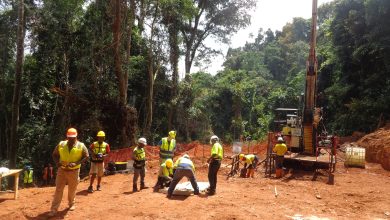OEMs demonstrate that indeed Necessity is the mother of invention, as they develop and release to the market, drilling equipment to meet current requirements of underground mining.
Extraction activities in Platinum Group Metals and gold mines are going deeper. As they venture into this unforgiving terrain, in various tasks, mine operators have to contend with contemporary challenges such as skyrocketing energy costs, increasing safety risks, low productivity and environmental compliance. Effectively managing these can ensure the long-term sustainability of mining.
Rock drilling
Consequently, utilising every facet of operations to achieve this end is vital. Fortunately, one of the spheres when opportunities beckon is rock drilling.
Unfortunately, the traditional techniques of rock drilling demonstrate limitations. Naturally, this necessitates mine operators to embrace proven innovative drilling technologies.
Accordingly, responding to this need, on the R&D front, OEMs have been developing machinery equipped with ground-breaking features once considered the stuff of sci-fi just over a decade ago. Encouragingly, when deployed on a commercial scale, it has been established that the machinery is helping mine operators cope with contemporary challenges.
Shortcomings of traditional techniques
Certainly, the relevance of new technologies becomes clearer by examining the limitations of traditional drilling techniques and how they impact operations at the outset, particularly in the following areas:
- Environment
There is a global shift towards decarbonisation, with mining one of the sectors obliged to comply. But what do traditional drilling equipment/tools offer towards achieving that end?
However, due to their inefficiencies, traditional techniques involve over-drilling, which burns more fuel, producing more emissions. Conversely, efficient drilling would burn less fuel, reducing emissions. Thus, Minimising the environmental impacts of mining processes has never been of greater importance.
- Energy
Power costs could have increased by as much as five-fold in the last few years. Of course. This differs from country to country. But the fact is that generally, prices are not getting any cheaper, which is tellingly impacting energy-intensive industries like mining.
Unfortunately, most conventional drilling systems, such as those using compressed air, are known to be very energy-intensive. On a deep level, there is even more energy required, prompting the adoption of alternative techniques.
- Productivity
In the area of production, labour costs have increased but the same cannot be said about productivity. This is a typical scenario in South Africa. Mining companies are under pressure to accede to the demands of labour unions for wage increases of their members, most of whom drilling operators. Some mining heads have deemed meeting the demands unsustainable, as they are not linked to productivity.
Hence, to increase productivity among drill operators, there is a need to improve the utilisation of equipment. But do traditional drilling techniques help in the quest for high productivity?
Fatigue is among the numerous problems that drill operators encounter with traditional drilling machinery. For instance, with a heavy rock drill, the time required and the task involved in assembling and disassembling causes fatigue. As a result, operators would be too tired to perform tasks effectively. This hinders efforts to increase productivity.
- Occupational health and safety risk
Traditional drilling machinery places operators very close to the rock face, exposing the workers to several occupational health and safety risks. Firstly, they face the risk of serious injury, at best, and fatalities, at worst. In addition, exposure to emissions with high diesel particulate matter (DPM) content poses a high risk of lung cancer or silicosis. This is without mentioning that noisier pneumatic drill rigs, for instance, expose operators to a high risk of noise-induced hearing loss. Usually, the noise decibel levels are above the environmental noise level and safety threshold.
Evidently, this situation calls for equipment that meets the production and occupational health and safety requirements.
Trailblazing innovations
Timely, trailblazing machinery innovations are being released on the market. When deployed on a commercial scale, it is registering compelling success. Demonstrably, there are substantial gains from adopting them. Particularly changing the game are hydro drilling, automation
- Hydro drilling
Hydrodrilling employs high-pressure water, instead of compressed air, to power rock drills and other mining equipment. Thus far, hydropower drilling machinery from two South African OEMs, Novatek and Hydro Power Equipment (HPE) has been trialled in platinum and gold mines in South Africa. The results indicate that there are significant opportunities for energy savings, occupational health and safety, water efficiency, and improving efficiency.
At Impala Platinum’s mine in Rustenburg, the mine management claimed to have noticed a 37% increase in production, as well as reduced water use by 60% and electricity use by 80%. Additionally, hydro drilling resulted in significant noise reduction of noise from traditional DTH drilling activity from 109 decibels to 103 decibels. This was a significant reduction in exposure to noise-induced hearing loss.
Encouraged by the results, the mining companies involved in the trials have decided to completely remove compressed air from their operations and equip their mining crews with hydropower drilling machines.
- Automation
From reports of the feats it is accomplishing in underground mining operations, doubtless, automation has revolutionised drilling. Powered by electric motors, automated drills feature cutting-edge technology in drilling automation, data management, and tele-remote operations.
Noteworthy, the adoption of automated drilling results in gains mainly in two areas, safety and productivity.
In terms of safety, autonomous drilling greatly reduces the presence of workers in the face of drilling activity. In this way, it significantly minimises their risk of serious injury or fatalities.
Furthermore, from a productivity standpoint, automation means traditional workforce requirements are not needed. This frees up staff for other essential duties, which improves efficiency across the board.
- Battery-operated capabilities
A battery-operated drill rig not only delivers improved productivity but also improves health conditions for miners. It reduces diesel fume particulate matter which mining workforces are constantly exposed to. Moreover, by eliminating diesel emissions, it minimises the need for ventilation.
- New raised boring equipment
Electro-hydraulic, fully mechanised, self-contained, and independent mobile drill equipment can perform ascending or descending drilling. Developed and popularised by Sandvic, the equipment is capable of eliminating the challenges associated with traditional raise boring machines.
Unlike traditional raise boring machines, the new raise boring equipment rewrites the modus operandi. The equipment does not require a concrete pad, additional rock works or any special utilities or provisions besides the ones fitted on the equipment.
Sparing no effort
These technological advances highlighted are only a small part of the whole. Vividly, from the foregoing, OEMs are sparing no effort unturned in pursuit of technologies that help mine operators navigate unforgiving environments to ensure improved safety and efficiency, as well as environmentally friendly compliance.






